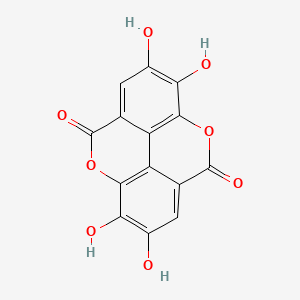m6A-centered Drug Response Information
General Information of the Drug (ID: M6APDG02261)
| Name |
ELLAGIC ACID
|
||||
|---|---|---|---|---|---|
| Synonyms |
ellagic acid; 476-66-4; Benzoaric acid; Lagistase; Eleagic acid; Alizarine Yellow; Elagostasine; 2,3,7,8-Tetrahydroxychromeno[5,4,3-cde]chromene-5,10-dione; Ellagic acid dihydrate; Llagic acid; Acide ellagique; Acido elagico; Acidum ellagicum; C.I. 55005; Gallogen (VAN); Gallogen (astringent); C.I. 75270; Ellagate; Ellagic acid [INN:DCF]; UNII-19YRN3ZS9P; Acido elagico [INN-Spanish]; CCRIS 774; Gallogen, astringent; Acide ellagique [INN-French]; Acidum ellagicum [INN-Latin]; MLS000069632; C14H6O8; EINECS 207-508-3; NSC407286; NSC 40728
Click to Show/Hide
|
||||
| Status |
Investigative
|
||||
| Structure |
 |
||||
| Formula |
C14H6O8
|
||||
| InChI |
1S/C14H6O8/c15-5-1-3-7-8-4(14(20)22-11(7)9(5)17)2-6(16)10(18)12(8)21-13(3)19/h1-2,15-18H
|
||||
| InChIKey |
AFSDNFLWKVMVRB-UHFFFAOYSA-N
|
||||
| PubChem CID | |||||
| TTD Drug ID | |||||
Target Gene(s) and Their Upstream m6A Regulator, Together with the Effect of Target Gene(s) in Drug Response
The target genes involved in drug-target interaction (such as drug-metabolizing enzymes, drug transporters and therapeutic targets) and drug-mediated cell death signaling (including modulating DNA damage and repair capacity, escaping from drug-induced apoptosis, autophagy, cellular metabolic reprogramming, oncogenic bypass signaling, cell microenvironment, cell stemness, etc.) could be regulated by m6A regulator(s) and affected their corresponding drug response. You can browse detailed information on drug-related target gene(s) mediated by m6A regulators.
Glycogen synthase kinase-3 beta (GSK-3B)
Fat mass and obesity-associated protein (FTO)
| In total 1 mechanisms lead to this potential drug response | ||||
| Response Summary | Glycogen synthase kinase-3 beta (GSK-3B) is a therapeutic target for ELLAGIC ACID. The Fat mass and obesity-associated protein (FTO) has potential in affecting the response of ELLAGIC ACID through regulating the expression of Glycogen synthase kinase-3 beta (GSK-3B). | [1], [2] | ||
Methyltransferase-like 14 (METTL14)
| In total 1 mechanisms lead to this potential drug response | ||||
| Response Summary | Glycogen synthase kinase-3 beta (GSK-3B) is a therapeutic target for ELLAGIC ACID. The Methyltransferase-like 14 (METTL14) has potential in affecting the response of ELLAGIC ACID through regulating the expression of Glycogen synthase kinase-3 beta (GSK-3B). | [2], [3] | ||
Mothers against decapentaplegic homolog 3 (SMAD3)
ETS-related transcription factor Elf-3 (ELF3)
| In total 1 mechanisms lead to this potential drug response | ||||
| Response Summary | Mothers against decapentaplegic homolog 3 (SMAD3) is a therapeutic target for ELLAGIC ACID. The ETS-related transcription factor Elf-3 (ELF3) has potential in affecting the response of ELLAGIC ACID through regulating the expression of Mothers against decapentaplegic homolog 3 (SMAD3). | [4], [5] | ||
Methyltransferase-like 3 (METTL3)
| In total 1 mechanisms lead to this potential drug response | ||||
| Response Summary | Mothers against decapentaplegic homolog 3 (SMAD3) is a therapeutic target for ELLAGIC ACID. The Methyltransferase-like 3 (METTL3) has potential in affecting the response of ELLAGIC ACID through regulating the expression of Mothers against decapentaplegic homolog 3 (SMAD3). | [5], [6] | ||
RNA demethylase ALKBH5 (ALKBH5)
| In total 1 mechanisms lead to this potential drug response | ||||
| Response Summary | Mothers against decapentaplegic homolog 3 (SMAD3) is a therapeutic target for ELLAGIC ACID. The RNA demethylase ALKBH5 (ALKBH5) has potential in affecting the response of ELLAGIC ACID through regulating the expression of Mothers against decapentaplegic homolog 3 (SMAD3). | [5], [7] | ||
YTH domain-containing family protein 2 (YTHDF2)
| In total 1 mechanisms lead to this potential drug response | ||||
| Response Summary | Mothers against decapentaplegic homolog 3 (SMAD3) is a therapeutic target for ELLAGIC ACID. The YTH domain-containing family protein 2 (YTHDF2) has potential in affecting the response of ELLAGIC ACID through regulating the expression of Mothers against decapentaplegic homolog 3 (SMAD3). | [5], [8] | ||
References